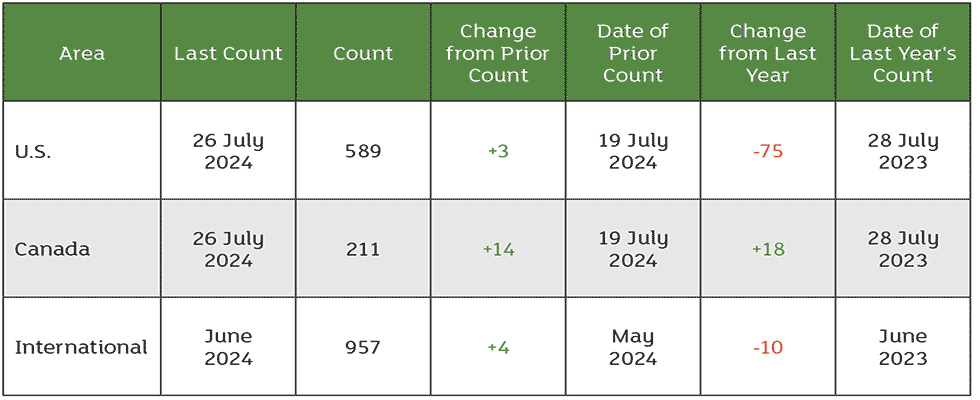
The Consumer Price Index for All Urban Consumers (CPI-U) fell 0.1% in June, following no change in May. Over the past year, the CPI-U rose 3.0%. The gasoline index dropped 3.8% in June, and the overall energy index fell 2.0%. The food index increased by 0.2%. Excluding food and energy, the index rose 0.1%. Over the last year, the core CPI rose 3.3%, the smallest increase since April 2021.
The Producer Price Index (PPI) for final demand rose 0.2% in June, following no change in May and a 0.5% increase in April. Over the past year, the PPI increased 2.6%, the largest rise since March 2023. The June increase was driven by a 0.6% rise in final demand services, while final demand goods fell by 0.5%.
In June, United States import prices remained unchanged after a 0.2% decline in May, with lower fuel prices offsetting higher nonfuel prices. Export prices fell by 0.5% following a 0.7% drop in May.
The U.S. Bureau of Labor Statistics reported the number of job openings remained steady at 8.2 million on the last business day of June. Hires and total separations also saw little change, standing at 5.3 million and 5.1 million, respectively. Job openings increased in accommodation and food services and state and local government, excluding education, but decreased in durable goods manufacturing and the federal government. Over the year, job openings were down by 941,000. The hires rate was unchanged at 3.4%, and total separations decreased by 544,000 over the year.
The U.S. economy has recently decelerated, with real gross domestic product (GDP) growth slowing from an annualized rate of 3.4% in Q4-2023 to just 1.4% in Q1-2024. Although continued expansion is expected in the coming quarters, growth rates are likely to fall short of the 2.4% annual average seen during the 2010-2019 period.
The deceleration in economic activity has led to a softer labor market, with slower payroll growth and a rising unemployment rate, resulting in moderated wage growth. This slowdown has eased inflationary pressures, as evidenced by the core CPI rising only 0.2% in May and 0.1% in June.
The Federal Open Market Committee (FOMC) is anticipated to begin an easing cycle with a 25 basis point rate cut at its September meeting, followed by another 25 basis point cut in December and an additional 100 basis points of policy easing in 2025.
Despite concerns about the proximity of the Nov. 5 presidential election, historical FOMC meeting transcripts indicate political considerations do not influence policy decisions, suggesting economic conditions will guide anticipated rate cuts.
Wells Fargo’s International Economic Outlook Report for July expects global GDP growth to remain at 2.9%. The report lowered China’s GDP forecast to 4.8% but raised India’s to 7.3% and the U.K.’s to 1.0%. The monetary policy forecast remained largely unchanged, anticipating most advanced economy central banks will reduce interest rates gradually due to ongoing inflation concerns.
Canada is expected to implement an earlier rate cut in July due to softer economic conditions and contained inflation. The report outlined a forecast of a slightly slower paced medium-term U.S. dollar depreciation, acknowledging more expansive fiscal policies and increasing tariffs could sustain the dollar’s strength longer than initially anticipated.

